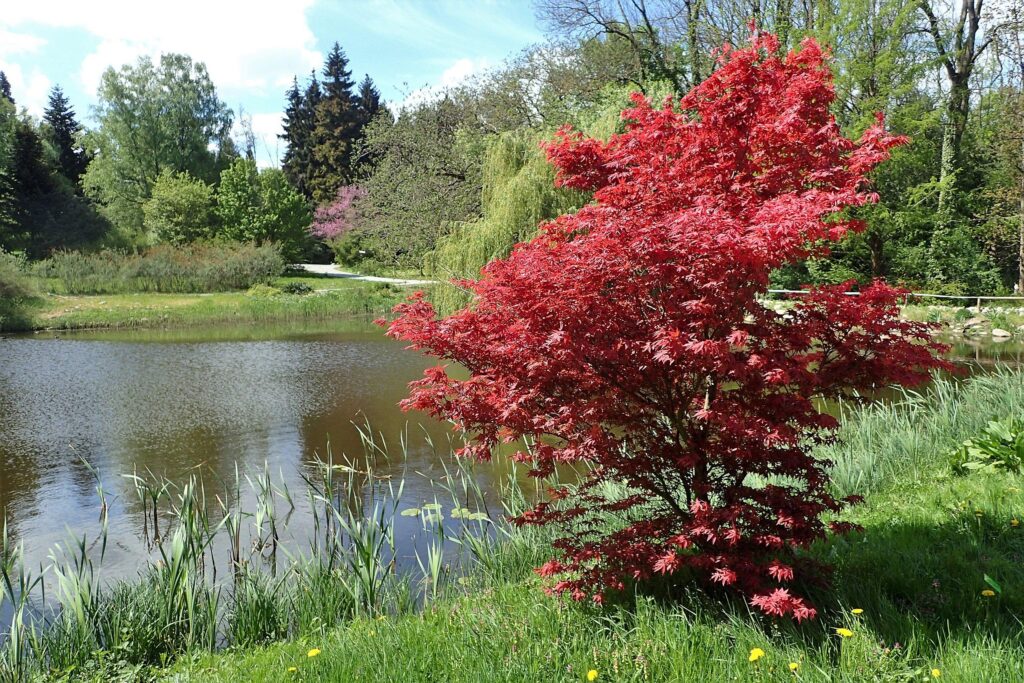

Japanese Maple (Acer palmatum)
Also known as: Acer palmatum.
The Japanese Maple, or Acer Palmatum, is a beautiful small tree and an amazing addition to any landscape. Its delicate foliage offers an incredible range of colors, from vibrant reds to deep greens throughout the growing season. In the fall, its leaves turn yellow and oranges, and finally bronze. With its intricate branches and vibrant colors, it is a sight to behold. This species is also preferred for its versatility, as it grows well in both container gardens and in large outdoor spaces. Its petite size makes it an ideal choice for a variety of settings, making it a great all-around choice for any garden.
7 Fascinating Facts About the Japanese Maple (Acer palmatum)
The Japanese Maple (Acer palmatum), with its delicate leaves and graceful form, is a beloved sight in gardens and landscapes worldwide. Here are 7 fascinating facts about this unique and mesmerizing tree:
- A Kaleidoscope of Color: Unlike most maples known for their fiery red fall foliage, Japanese Maples come in a stunning variety of colors beyond just red. From vibrant oranges and yellows to deep purples and even variegated shades, these trees offer a breathtaking spectrum of color throughout the year, not just in autumn.
- Beyond a Single Species: Don’t be fooled by the name! The Japanese Maple isn’t just one singular species. Over 1,000 different cultivars exist, each with its own unique characteristics like leaf shape, size, growth pattern, and even color variations.
- Miniature Marvels: Patience and artistry combine in the world of bonsai, and the Japanese Maple is a favorite choice for this ancient art form. Their slow growth, delicate features, and ability to respond well to shaping make them ideal candidates for creating living miniature masterpieces.
- A Historical Symbol: In Japanese culture, the Maple tree holds deep symbolic meaning. Often associated with autumn and impermanence, it appears in traditional paintings, literature, and even tea ceremonies, representing beauty, change, and the fleeting nature of life.
- Musical Muse: Not only pleasing to the eye, the Japanese Maple can also delight the ear. Its leaves, when gently swayed by the wind, create a soft rustling sound, reminiscent of gentle music, adding a layer of sensory experience to its presence.
- More Than Just Beauty: While primarily admired for its ornamental value, the Japanese Maple does have some historical medicinal uses. In traditional practices, bark and leaves were used for various ailments, although modern science still needs to validate these claims.
- Global Grace: Though originating in Japan, Korea, and China, the Japanese Maple has captivated people worldwide. Its adaptability to various climates and its stunning visual appeal have made it a popular choice in gardens across continents, leaving a touch of Asian elegance in diverse landscapes.
I hope these facts provide a glimpse into the world of the Japanese Maple, its captivating qualities, and its enduring appeal!
Plant care guide:
Watering
Water Japanese Maple trees at least once every week. Watering should be done in the morning or early evening when temperatures are mild, as hot temperatures can cause water droplets to magnify and burn the leaves. Check the soil before watering to see if it is dry, and if it has been, water generously; if the soil is still damp from the last watering, ease back on the amount of water used. When you do water, be sure to water the root zone of the tree and not just the leaves.
Sunlight
Japanese Maple should be placed in a spot that receives 3-6 hours of direct sunlight per day, preferably in the morning for best results. Direct midday sun should be avoided as this could cause leaf scorch. Japanese Maples can also tolerate partial shade, but will not thrive if placed in a full shade location. If possible, the plant should be sheltered from strong winds, which can scorch the leaves, and it should be watered regularly throughout the growing season.
Pruning
Pruning Japanese Maples should take place in late winter to early spring when the trees are still dormant. Pruning should be light, removing no more than 1/3 of the total canopies of the maple trees. Pruning should focus on removing dead and crossing branches, thinning out dense areas, and cutting back long and unruly branches. This will allow light and air to penetrate the canopy, improve structural strength, and help prevent disease and pest infestations. Generally, no more than 5 branches should be removed in 1 season as it can cause undue stress for the tree if more than that is taken away.
Plant information:
- Family: Sapindaceae
- Type: Tree
- Height: ~6.1 meters
- Cycle: Perennial
- Growth Rate: Low
- Flower Color: Reddish-purple
- Maintenance: Low
- Care Level: Moderate
-
Watering:
- Average
- Period: morning
- Sunlight requirement: Full sun, part shade
- Pruning:
- February, March, April
- Propagation: Air Layering Propagation, Grafting Propagation, Cutting, Seed Propagation
- Pest Susceptibility: Anthracnose, Canker, Sap rot, Caterpillar, Cutworm, Mildew, Wilt, Pest resistant, Disease resistant, Rabbit resistant
- Flowering Season: Spring
- Soil: Well-drained
- Fruit Color: green, red, yellow, purple, orange, maroon, burgundy
- Harvest Season: Fall
- Origin: Korea, Japan
- Seeds: Yes
- Drought Tolerant: No
- Salt Tolerant: No
- Thorny: No
- Invasive: No
- Tropical: No
- Indoor: No
- Flowers: Yes
- Cones: No
- Fruits: Yes
- Edible Fruit: No
- Leaf: Yes
- Edible Leaf: No
- Cuisine: No
- Medicinal: Yes
- Poisonous to Humans: No
- Poisonous to Pets: No

Content is based on public databases such as the KEW Plants of the World database, among others. Please double-check all information. "About Plants" does not take responsibility for any inaccuracies.
